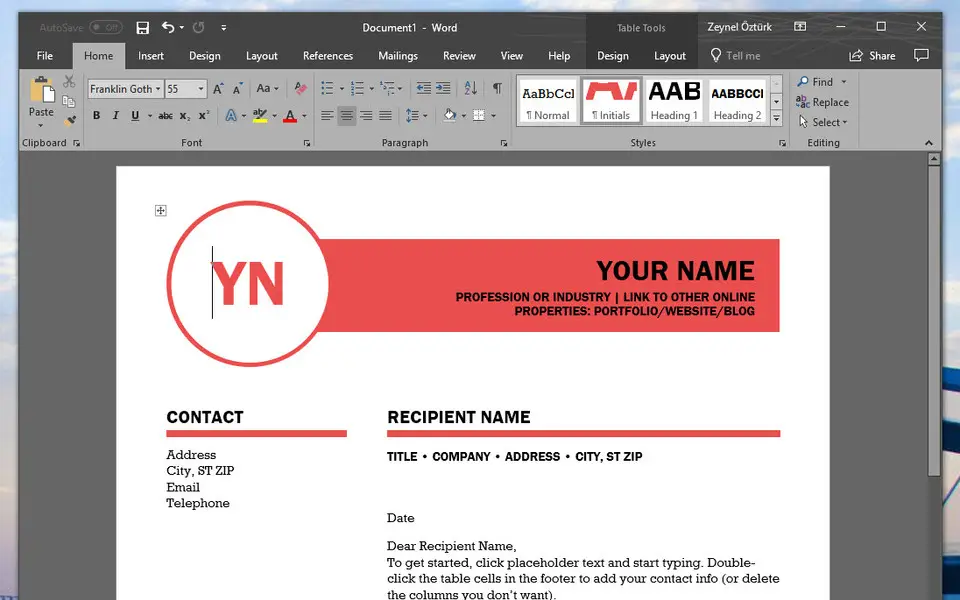|
|
Insert an empty field |
||
|
|
Choose the Print Preview command. |
||
|
|
Display Microsoft System Information |
||
|
|
To the top of the previous page |
||
|
|
Switch to Read Mode view |
||
|
|
Extend a selection one character to the right |
||
|
|
Remove the document window split |
||
|
|
One paragraph up |
||
|
|
Delete one character to the left |
||
|
|
Tab characters in a cell |
||
|
|
Apply subscript formatting (automatic spacing) |
||
|
|
Preview a mail merge |
||
|
|
An en dash |
||
|
|
Single-space lines |
||
|
|
Edit a mail-merge data document |
||
|
|
Insert a merge field |
||
|
|
One character to the left |
||
|
|
Save a document |
||
|
|
Cycle through floating shapes, such as text boxes or images (press Tab repeatedly) |
||
|
|
Extend a selection to the end of a window |
||
|
|
Expand text under a heading |
||
|
|
To the top of the next page |
||
|
|
Cut to the Spike |
||
|
|
Move from an open dialog box back to the document, for dialog boxes that support this behavior |
||
|
|
Repeat the last action |
||
|
|
Choose the Go To command (Home tab) |
||
|
|
Choose the Spelling command (Review tab) |
||
|
|
Start context-sensitive Help or reveal formatting |
||
|
|
Create a new Building Block |
||
|
|
Maximize the document window |
||
|
|
To the beginning of a line |
||
|
|
Extend a selection one screen up |
||
|
|
Extend a selection to the end of a word |
||
|
|
Extend a selection to the end of a line |
||
|
|
Move the focus to a different pane of the window, such as the Format Picture pane, the Grammar pane, or the Selection pane |
||
|
|
Go back one page |
||
|
|
Double-space lines |
||
|
|
Set 1.5-line spacing |
||
|
|
Print the merged document |
||
|
|
Row up |
||
|
|
Open the Office Clipboard |
||
|
|
Copy text or graphics once |
||
|
|
To the first cell in a row |
||
|
|
Switch to print preview |
||
|
|
One cell to the right (in a table) |
||
|
|
Open the search box in the Navigation task pane |
||
|
|
Extend a selection one line down |
||
|
|
Select a vertical block of text |
||
|
|
Restore the program window size |
||
|
|
Choose the Save As command |
||
|
|
Update the selected fields |
||
|
|
Show KeyTips |
||
|
|
Get Help or visit Office.com. |
||
|
|
Turn Chinese Input Method Editor (IME) on 101 keyboard on or off |
||
|
|
Go to the next field |
||
|
|
Switch between a field code and its result |
||
|
|
Extend a selection one character to the left |
||
|
|
Reduce the size of a selection |
||
|
|
Hide or display character formatting |
||
Advertisement |
|||
|
|
Show all headings up to Heading 1-9. |
||
|
|
One cell to the left (in a table) |
||
|
|
Down one screen (scrolling) |
||
|
|
Collapse text under a heading |
||
|
|
Print a document |
||
|
|
Up one line |
||
|
|
Down one line |
||
|
|
One character to the right |
||
|
|
Activate a selected command or control on the ribbon |
||
|
|
To the previous cell in a row |
||
|
|
To the first cell in a column |
||
|
|
A single opening quotation mark |
||
|
|
(after you type the first few characters of the AutoText entry name and when the ScreenTip appears) An AutoText entry |
||
|
|
A single closing quotation mark |
||
|
|
while holding, type character code (on the numeric keypad): Insert the ANSI character for the specified ANSI (decimal) character code. For example, to insert the euro currency symbol, hold down Alt and press 0128 on the numeric keypad |
||
|
|
Apply the Normal style |
||
|
|
Row down |
||
|
|
Increase the font size by 1 point |
||
|
|
To the next cell in a row |
||
|
|
(with Num Lock off) Select an entire table |
||
|
|
Select the column from top to bottom |
||
|
|
Move text or graphics once |
||
|
|
Delete one character to the right |
||
|
|
Open a selected menu or gallery on the ribbon |
||
|
|
Finish modifying a value in a control on the ribbon, and move focus back to the document |
||
|
|
Move by one preview page when zoomed out |
||
|
|
Close the Reviewing Pane if it is open. |
||
|
|
Up one screen (scrolling) |
||
|
|
Go to page 1-9 |
||
|
|
Extend a selection to a specific location in a document |
||
|
|
Go to the next window |
||
|
|
Display a menu or message for an available action |
||
|
|
Run GOTOBUTTON or MACROBUTTON from the field that displays the field results |
||
|
|
Display a shortcut menu |
||
|
|
Reduce the size of a selection |
||
|
|
Go to the next pane or frame |
||
|
|
Exit Read mode |
||
|
|
Turn extend mode on |
||
|
|
Select the nearest character |
||
|
|
(press once to select a word, twice to select a sentence, and so on) Increase the size of a selection |
||
|
|
Turn extend mode off |
||
|
|
Go to beginning of document |
||
|
|
Go to end of document. |
||
|
|
Move around the preview page when zoomed in |
||
|
|
Go forward one page |
||
|
|
Cut selected text or graphics to the Office Clipboard |
||
|
|
When the building block — for example, a SmartArt graphic — is selected, display the shortcut menu that is associated with it |
||
|
|
To the last cell in a row |
||
|
|
Double closing quotation marks |
||
|
|
Open object dialog box. Then Press down arrow to select an object type and press Enter to create an object |
||
|
|
Update selected fields |
||
|
|
Create a new document |
||
|
|
Move the focus to each command on the ribbon, forward or backward, respectively |
||
|
|
Display Microsoft Visual Basic code |
||
|
|
Find out the Unicode character code for the selected character |
||
|
|
Insert a LISTNUM field |
||
|
|
Open Apply Styles task pane. |
||
|
|
Create a hanging indent |
||
|
|
Unlock a field |
||
|
|
Cut to the Spike (Spike is a feature that allows you to collect groups of text from different locations and paste them in another location) |
||
|
|
Move the focus to commands on the ribbon |
||
|
|
Apply italic formatting |
||
|
|
Apply an underline |
||
|
|
Expand or collapse all text or headings |
||
|
|
To manage Mail Merge tasks, or to work with envelopes and labels, open Mailings tab |
||
|
|
Extend a selection to the beginning of a word |
||
|
|
Open the Font dialog box to change the font. |
||
|
|
Go to the next field |
||
|
|
Increase the font size |
||
|
|
Copy selected text or graphics to the Office Clipboard |
||
|
|
Extend a selection to the beginning of a line |
||
|
|
Choose Table of Contents button in the Table of Contents container when the container is active. |
||
|
|
Go to the previous field |
||
|
|
One paragraph down |
||
|
|
Go to the previous field |
||
|
|
Exit the floating shape navigation and return to the normal navigation. |
||
|
|
Select the column from bottom to top |
||
|
|
Double opening quotation marks |
||
|
|
Select the active tab of the ribbon and activate the access keys |
||
|
|
Move to the last preview page when zoomed out |
||
|
|
Insert the contents of the Spike |
||
|
|
Open a selected menu or gallery on the ribbon |
||
|
|
When text or an object is selected, open the Create New Building Block dialog box |
||
|
|
To use themes, colors, and effects, such as page borders, open the Design tab |
||
|
|
To type a search term for Help content, open "Tell me" box on ribbon |
||
|
|
One word to the right |
||
|
|
Turn change tracking on or off |
||
|
|
Go to a page, bookmark, footnote, table, comment, graphic, or other location |
||
|
|
Refresh. |
||
|
|
Change the selection to the Symbol font |
||
|
|
Format all letters as capitals |
||
Microsoft Word 2019 keyboard shortcuts
Microsoft Word 2019
Table of contents
Advertisement
Program information
Program name:

Web page: products.office.com/word
Last update: 09.09.2022 11:40 UTC
How easy to press shortcuts: 74%
More information >>
Updated: Added some shortcuts.
(4 updates.)
06.07.2019 05:54:24 Updated program information.
24.12.2019 11:20:52 Updated program information.
24.12.2019 11:25:58 Updated program information.
26.12.2020 20:24:22 Added some shortcuts.
Shortcut count: 315
Platform detected: Windows or Linux
Featured shortcut
Similar programs
Tools
Microsoft Word 2019:Learn: Jump to a random shortcut
Hardest shortcut of Microsoft Word ...
Other




What is your favorite Microsoft Word 2019 hotkey? Do you have any useful tips for it? Let other users know below.
1108032
498772
411518
366987
307454
277921
14 hours ago
14 hours ago Updated!
2 days ago
3 days ago
3 days ago
4 days ago Updated!
Latest articles